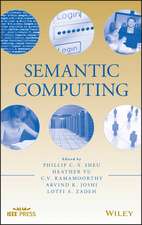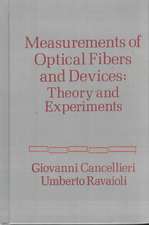Fundamentals of Applied Electromagnetics, Global Edition
Autor Fawwaz Ulaby, Umberto Ravaiolien Limba Engleză Paperback – 21 mar 2022
Bridging the gap betweencircuits and electromagnetics
Widely in the field,this authoritative text bridges the gap between circuits and electromagneticsmaterial. Fundamentals of Applied Electromagnetics beginscoverage with transmission lines, leading students from familiar concepts intomore advanced topics and applications. The 8th Edition buildson the core content and style of previous editions, retaining thestudent-friendly approach and hands-on simulation modules that help studentsdevelop a deeper understanding of electromagnetic concepts and applications.Enhanced graphs and illustrations and an expanded scope of topics in theTechnology Briefs, establish additional bridges between electromagneticfundamentals and their countless engineering and scientific applications.
Preț: 470.80 lei
Preț vechi: 541.15 lei
-13% Nou
Puncte Express: 706
Preț estimativ în valută:
90.12€ • 97.92$ • 75.75£
90.12€ • 97.92$ • 75.75£
Carte disponibilă
Livrare economică 31 martie-14 aprilie
Livrare express 14-20 martie pentru 50.80 lei
Preluare comenzi: 021 569.72.76
Specificații
ISBN-13: 9781292436739
ISBN-10: 1292436735
Pagini: 496
Dimensiuni: 215 x 272 x 22 mm
Greutate: 1.08 kg
Ediția:8. Auflage
Editura: Pearson
ISBN-10: 1292436735
Pagini: 496
Dimensiuni: 215 x 272 x 22 mm
Greutate: 1.08 kg
Ediția:8. Auflage
Editura: Pearson
Cuprins
- Introduction: Waves and Phasors
- Transmission Lines
- Vector Analysis
- Electrostatics
- Magnetostatics
- Maxwells Equations for Time-Varying Fields
- Plane-Wave Propagation
- Wave Reflection and Transmission
- Radiation and Antennas
- Satellite Communication Systems and RadarSensors
- Appendix A Symbols, Quantities, and Units
- Appendix B Material Constants of Some Common Materials
- Appendix C Mathematical Formulas
- Appendix D Answers to Selected Problems
Notă biografică
Fawwaz Ulaby Since joining the University of Michigan faculty in 1984, Professor Ulaby has directed numerous interdisciplinary projects aimed at the development of high-resolution satellite radar sensors for mapping Earth's terrestrial environment. He also served as the founding director of the NASA-funded Center for Space Terahertz Technology, whose research was aimed at the development of microelectronic devices and circuits that operate at wavelengths between the infrared and the microwave regions of the electromagnetic spectrum. He then served a seven-year term as the University of Michigan's vice president for research from1999-2005. Over his academic career, he has published 10 books and supervised more than 100 graduate students.
Professor Ulaby is a member of the U.S. National Academy of Engineering, Fellow of the American Association for the Advancement of Science (AAAS) and the Institute of Electrical and Electronic Engineers (IEEE), and serves on several international scientific boards and commissions. In recognition for his outstanding teaching and distinguished scholarship, he has been the recipient of numerous honors and awards from universities, government agencies, and scientific organizations. Among them are the NASA Achievement Award (1990), the IEEE Millennium Medal(2000), the 2002 William Pecora Award, a joint recognition by NASA and the Department of the Interior, and the Distinguished FEA Alumni Award from the American University of Beirut (2006). In 2006, he was selected by the students in the Department of Electrical Engineering and Computer Science as "Professor of the Year," and shortly thereafter, he was awarded the Thomas Edison Medal, the oldest medal in the field of electrical and computer engineering in the United States.
Umberto Ravaioli Professor Ravaioli attended the University of Bologna, Italy, where he obtained degrees in Electronics Engineering and Physics. He conducted his dissertation work on fiber optics and microwaves at the laboratories of the Marconi Foundation in Villa Griffone, the summer estate where Guglielmo Marconi performed his first radio experiments. After developing interests in high-speed semiconductor devices and large-scale computation, he pursued a Ph.D. in Electrical Engineering at Arizona State University, where he developed Monte Carlo particle simulations for the high electron mobility transistor.
He joined the Department of Electrical and Computer Engineering of the University of Illinois at Urbana-Champaign in 1986. He was a co-founder of the National Center for Computational Electronics, which promoted for over a decade the development of large-scale device simulation by leveraging resources at national supercomputing centers. His research group has developed Monte Carlo and quantum simulators for a wide range of semiconductor device applications, expanding recent activities to charge transport in biological systems, coupled electro-thermal simulation, and nanoelectronics. He is now the leader of the Computational Multiscale Nano-systems group at the Beckman Institute of the University of Illinois and is also serving as Senior Assistant Dean for Undergraduate Programs in the College of Engineering.
Professor Ravaioli is a Fellow of the Institute of Electrical and Electronic Engineers (IEEE) and a Fellow of the Institute of Physics (IOP). He received the First Place Outstanding Paper Award at the 2007 IEEE International Conference on Electron Information Technology for his recent work on electro-thermal simulation.
Professor Ulaby is a member of the U.S. National Academy of Engineering, Fellow of the American Association for the Advancement of Science (AAAS) and the Institute of Electrical and Electronic Engineers (IEEE), and serves on several international scientific boards and commissions. In recognition for his outstanding teaching and distinguished scholarship, he has been the recipient of numerous honors and awards from universities, government agencies, and scientific organizations. Among them are the NASA Achievement Award (1990), the IEEE Millennium Medal(2000), the 2002 William Pecora Award, a joint recognition by NASA and the Department of the Interior, and the Distinguished FEA Alumni Award from the American University of Beirut (2006). In 2006, he was selected by the students in the Department of Electrical Engineering and Computer Science as "Professor of the Year," and shortly thereafter, he was awarded the Thomas Edison Medal, the oldest medal in the field of electrical and computer engineering in the United States.
Umberto Ravaioli Professor Ravaioli attended the University of Bologna, Italy, where he obtained degrees in Electronics Engineering and Physics. He conducted his dissertation work on fiber optics and microwaves at the laboratories of the Marconi Foundation in Villa Griffone, the summer estate where Guglielmo Marconi performed his first radio experiments. After developing interests in high-speed semiconductor devices and large-scale computation, he pursued a Ph.D. in Electrical Engineering at Arizona State University, where he developed Monte Carlo particle simulations for the high electron mobility transistor.
He joined the Department of Electrical and Computer Engineering of the University of Illinois at Urbana-Champaign in 1986. He was a co-founder of the National Center for Computational Electronics, which promoted for over a decade the development of large-scale device simulation by leveraging resources at national supercomputing centers. His research group has developed Monte Carlo and quantum simulators for a wide range of semiconductor device applications, expanding recent activities to charge transport in biological systems, coupled electro-thermal simulation, and nanoelectronics. He is now the leader of the Computational Multiscale Nano-systems group at the Beckman Institute of the University of Illinois and is also serving as Senior Assistant Dean for Undergraduate Programs in the College of Engineering.
Professor Ravaioli is a Fellow of the Institute of Electrical and Electronic Engineers (IEEE) and a Fellow of the Institute of Physics (IOP). He received the First Place Outstanding Paper Award at the 2007 IEEE International Conference on Electron Information Technology for his recent work on electro-thermal simulation.
















